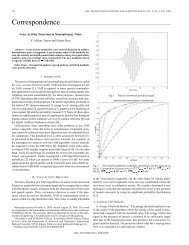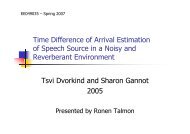Thesis (PDF) - Signal & Image Processing Lab
Thesis (PDF) - Signal & Image Processing Lab
Thesis (PDF) - Signal & Image Processing Lab
Create successful ePaper yourself
Turn your PDF publications into a flip-book with our unique Google optimized e-Paper software.
4.1. FILTERING USING AN ADAPTIVE STRUCTURING ELEMENT 49<br />
the resulting filter. As an example, Fig. 4.10 shows the filter effect for a filtering<br />
depth limit of 1 on a noisy image of Lena. Notice that a number of noisy pixels<br />
have survived the filtering. This artifact shows the typical problem of this approach.<br />
Fig. 4.7 shows a simple example that explains the effect. In the image shown, the<br />
upper pixel of component 3 is connected only to component 1. When in the erosion<br />
process the shown structure element (SE) is placed on this pixel, the infimum is taken<br />
between {103,-6,4} and {103,-5,2,-100}. The resulting infimum is {103,-5}. That<br />
infimum length is 2, and the alternating sequences are of length 3 and 4, respectively.<br />
Therefore, the length difference is 2, that is more than the filtering depth limit. In<br />
that case the noisy pixel is left untouched because the resulting infimum is much<br />
shorter then the source alternating sequence.<br />
Figure 4.7: An example of filtering a dual-pixel noise : A black component - 3, is<br />
located on brighter background - 1 and 2. After erosion with erosion depth limit of<br />
1, the upper pixel of the 3-rd component is untouched.<br />
This problem can be solved if we use a greater filtering depth limit. As an example,<br />
in Fig. 4.11, the adaptive structuring element method succeeds to filter more salt and<br />
pepper noise, but some of the “trenches” remain. Another solution is presented in<br />
section 4.3.
















